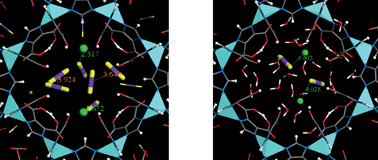A computational study is reported for the upgrade of natural gas (CO2/CH4 mixture) in rhozeolite-like metal–organic framework (ZMOF) and the effect of water on upgrade efficiency. CO2 is adsorbed predominantly over CH4, attributed to the strong electrostatic interactions of CO2 with ionic framework and extraframework Na+ ions. With increasing pressure, Na+ ions are coordinated and solvated increasingly by CO2 molecules. The distance between CO2 molecules becomes shorter with increasing pressure, while the distance between Na+ and CO2 remains more or less constant. Compared with other MOFs and nanoporous materials reported to date, rho-ZMOF exhibits exceptionally high selective adsorption for CO2/CH4 mixture. The selectivity is up to 3800 at infinite dilution and 80 at ambient condition. With a trace amount of H2O added into CO2/CH4 mixture, the interaction between CO2 and Na+ is reduced. Consequently, CO2 adsorption drops but CH4 adsorption is not discernibly affected, and the selectivity decreases by one order of magnitude. This work reveals that rho-ZMOF is a promising candidate for the separation of natural gas and H2O has a significant effect.

You have access to this article
 Please wait while we load your content...
Something went wrong. Try again?
Please wait while we load your content...
Something went wrong. Try again?


 Please wait while we load your content...
Please wait while we load your content...